More than ‘short supply’, profiteering by traders is behind the ongoing high prices. But why is the government beating around the bush instead of acting fast?
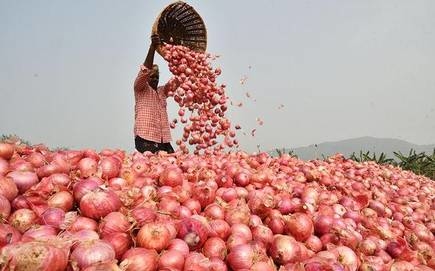
It is being said that the complex crop cycle has been disrupted, first due to last year’s drought in Maharashtra and Karnataka (two major onion producing states) followed by floods in both regions. Onions are sown three times in one year and supply is sustained round the year by storing some portion of the harvest (especially the winter one) to tide over lean months. There is some truth to this, as we will see later.
But first, have a look at another aspect. Taking Delhi as an example, onion was sold at the Azadpur mandi at a wholesale price of just Rs. 27.74 per kg but big traders and distributors sold it onwards at a retail price of Rs.42 per kg to small retailers. These in turn transported it to various local shops which sold onions at an average of Rs.60 per kg.
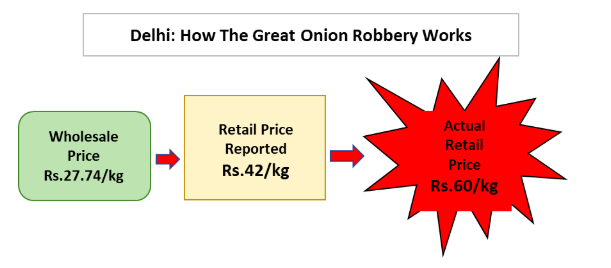
In other words, there was a 51% mark-up at the first stage, followed by a hefty 48% mark-up at the second stage. This, in a nutshell, is the way the onion price rise is playing out, whether in Delhi or elsewhere. Middlemen, especially big traders are making a huge killing in just a few days.
Having said this, let us look a bit deeper into the onion problem that keeps popping up every once in a while.
According to the third advance estimate of horticulture crops for 2018-19, issued by the agriculture ministry, onion production was 23.28 million tonnes in the agricultural year ending June 2019. This was practically the same as last year. So, it can’t be that onion supply has fallen drastically leading to a demand supply problem.
Yet, there is a sharp fall in the arrival of onions in wholesale markets, as per latest data from the National Horticulture Board (NHB). As the chart below comparing monthly arrival between January and September for 2018 and 2019 shows, last September, saw arrival of 3.98 lakh tonnes of onion while this year, till September 23, onion arrivals were less than half at 1.63 lakh tonnes.
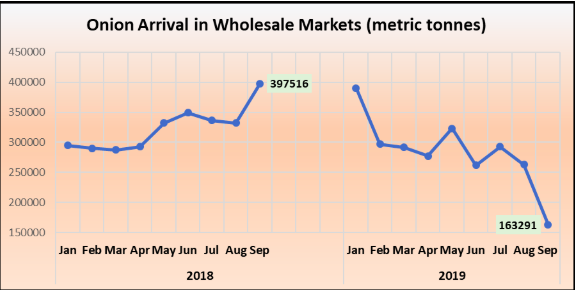
In fact, the current year is marked by a steady declining trend in onion arrivals, which is quite the reverse of last year. Given the fact that last year’s production was practically the same as this year, this is bizarre.
The only explanation is that the supply of onions from the two major producing regions is being artificially restricted. This is not something that is unknown – in the past there have been multiple complaints against cartels operating out of Mumbai and Bengaluru that corner and hoard huge onion stocks in order to drive up prices.
In addition, there is also some disruption caused by flooding – damage to stored onions from winter, and transportation difficulties. But these would not have caused supply to halve.
The effect of this restricted supply [See chart below] has been dramatic. Last year, onion prices fell till May then increased till July and then dipped slightly till September. But this year, there has been a steady rise throughout the year, according to NHB.
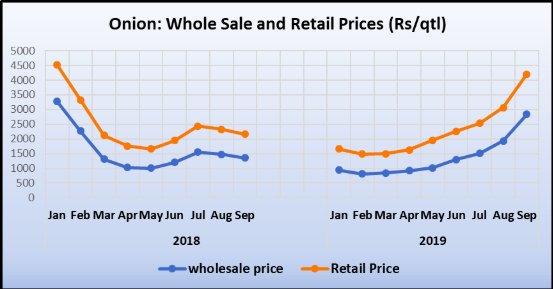
What is notable about the prices, and can be see clearly in the chart above, is that retail prices are consistently above wholesale prices by a considerable margin – upward of 40%. The farmers are thus getting much less prices while the consumers are paying through their nose.
Which brings us to the heart of the whole maze. In times of shortage, the absolute profit made by big traders rises phenomenally. They do pay slightly higher prices to farmers (or their proxies), but the mark-up goes up much more than in times of normal supply. As shown in the chart below, the difference between retail and wholesale prices has inexorably increased this year from about Rs.727 per quintal (or Rs.7.27 per kg) in January 2019 to a breathtakingly high of Rs.1,372 per quintal (Rs.13.72 per kg) currently, in September this year, according to NHB. That’s a near doubling of the margin that traders are making out of the onion trade.
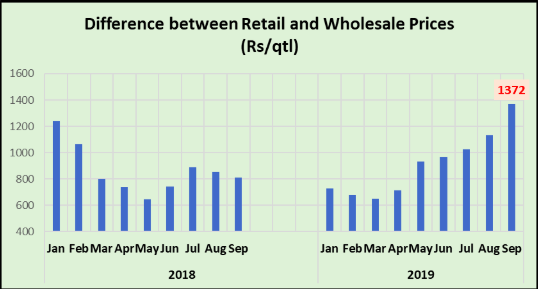
Note that last September the margin was Rs.808 per quintal, from which it has increased almost 70% to its present Rs.1,372 per quintal level.
That’s the real face of this Great Onion Robbery. And, what is the government doing about it? One has not heard of any raids on warehouses in Pune or Mumbai or Nashik or Bengaluru, although there are reports of thieves making off with tonnes of onions. Till date, the government has hiked up the minimum export price to prevent onion exports and issued a tender for import (withdrawing Pakistan’s name from it after protests). What was needed was swift and strong action against hoarders, breaking up of cartels and release of onions into the market to bring down prices. Also, onions could be procured and sold at affordable prices till the next crop comes in. All this would have saved people from unnecessary expenditure. The government’s inaction, especially in Maharashtra, which is the big centre of onion production, may have been driven by the impending Assembly polls in that state, many are speculating.
Courtesy: News Click
